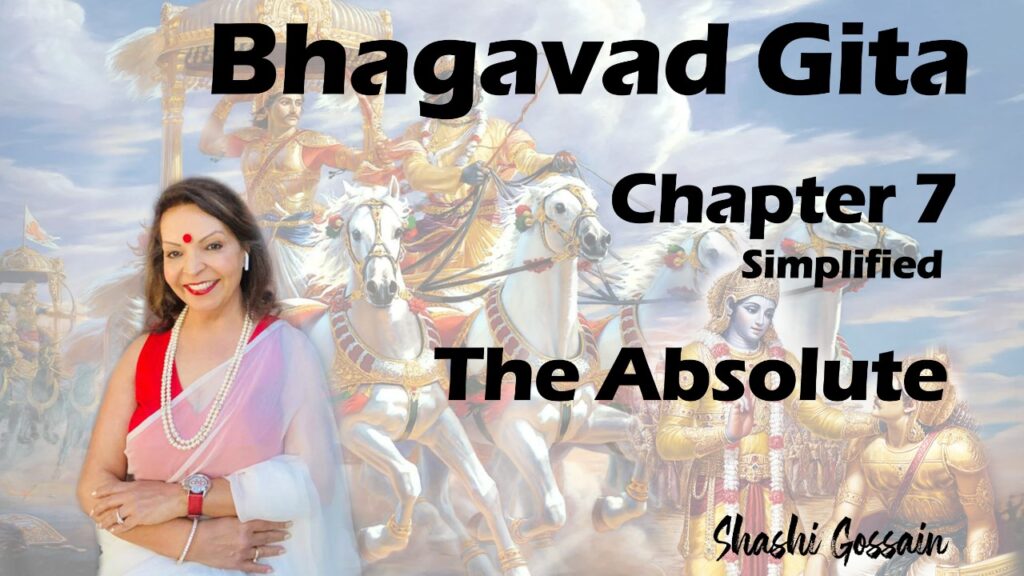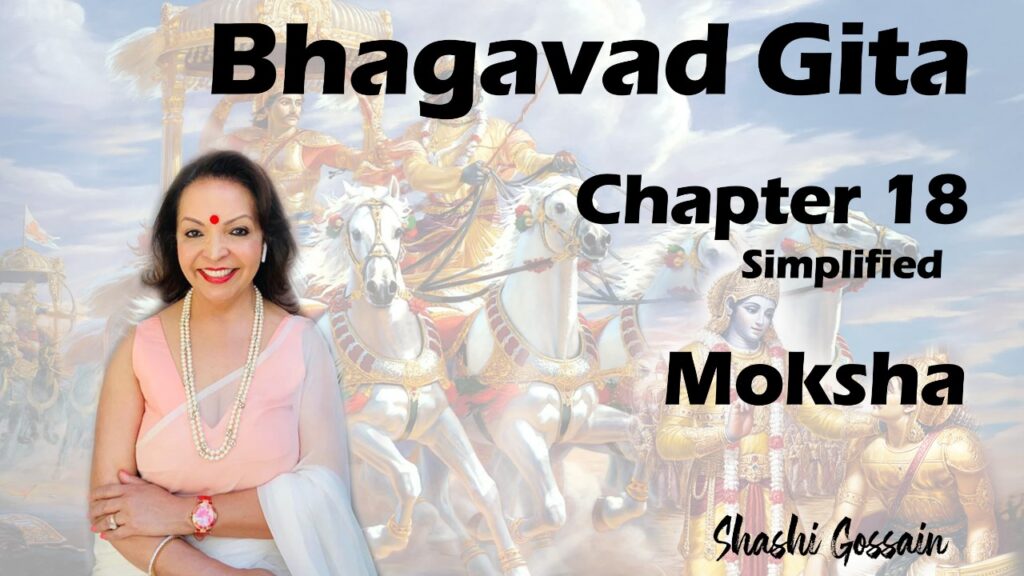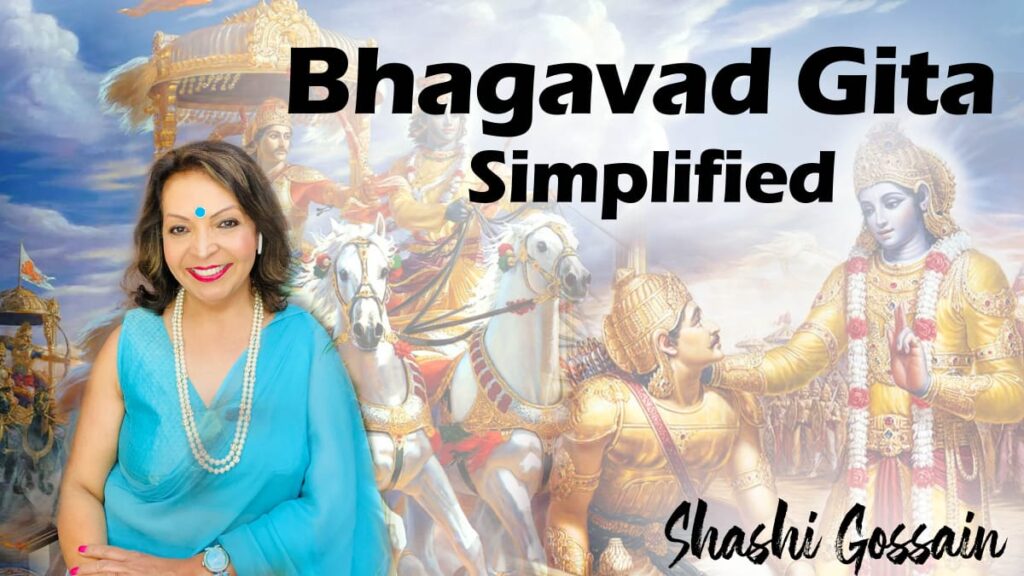Before we proceed to the seventh chapter of Bhagvat Gita, let’s recap what we have seen so far. Arjun, overcome with sorrow on the battlefield, pleaded to Shri Krishna to give him proper guidance. And Shri Krishna proceeded to give Arjun the teaching of the eternal essence, which was the primary topic of the second chapter.
- Step 1: Karmayoga: Purify the mind of selfish desires to gain supreme knowledge. (As our desires slowly get purified, it leads to)
- Step 2: Karma sanyasi: our activities reduce to the bare minimum, (leading to the final step)
- Step 3: Dhyana yoga or meditation
Chapter 7
What is the main message of Bhagavad Gita? What is the point of meditating?
In the sixth chapter, Shri Krishna elaborated upon the technique of meditation. But one question was left unanswered. That is, ‘What or who do we meditate upon?’ Now, Shri Krishna introduces the seventh chapter with a powerful message. Firstly, Shri Krishna wants us to understand his true nature, his completeness or “samagram”. It’s not what is just depicted in pictures, but the sheer vastness of his nature, which can address all our sorrows. He shows us that when we begin to develop an attachment and get an affinity to a higher ideal, the lower attachments to material things will automatically drop. Usually, when we are in distress, we take the support of our friends, family, or even wealth. But, none of these can guarantee their support & are unreliable. As we begin to develop devotion, or Bhakti yoga, towards Ishvara, we will realize that he is the only permanent support available. We will begin to rely on him solely, rather than on any other source of support. So therefore, Shri Krishna asks Arjun to pay attention to this message, as it’s not easy to grasp this concept.
What does Bhagavad Gita say about knowledge?
Shri Krishna says he will impart all the knowledge about God in his formless aspect, & the wisdom to recognize it. Shri Krishna says that those who seek this divine knowledge are extremely rare in this world. Out of thousands of people who try, very few will get to know Shri Krishna in his true, essential nature. Although millions go to the temple, fast, or do puja, they don’t really appreciate the full nature of the Lord’s essence.
What is the nature of Prakriti? And how can God be present at all places at the same time?
Shree Krishna says nature or Prakriti is not only made of mind, body, intellect, but 5 physical elements make up our universe. They are Earth, water, fire, wind, and space. The Lord created the entire cosmic world with these 5 elements or building blocks. He is present in the 5 elements, meaning: He is present in every object, present with us all the time. He also functions as a force that holds the whole universe together, otherwise, you would have random, flying atoms. As an analogy, he says he is the origin and cause of the universe. He pervades all things like a string pervades beads in a necklace. Here Shri Krishna differentiates “lower nature” as finite objects & “higher nature,” the spiritual nature of forces that sustain the universe. The lower nature and higher nature are both needed to create this universe. Also, everything that is created is sustained and ultimately dissolved into Ishvara. In other words, Ishvara creates, maintains, and dissolves the entire universe. So there’s a “cause” & ‘effect” e.g. When we hold a piece of cloth, what do we see? We see its color, its texture, its shape, and so on. But where did it come from? The cloth came from cotton threads, which came from a cotton plant, which came from a cottonseed, which at some point came from the earth. So the cause of the cloth was the earth, and the effect is the cloth. Unfortunately, our minds have been conditioned to focus on the effect, and not on the cause. We see the cloth and its attributes, but do not even think about the cause, because that requires our intellect to come into the picture. Most economic, social and political movements tend to fail because they only focus on the symptoms and not the cause. Therefore, Shri Krishna is asserting the fact that Ishvara is everywhere. Even though our eyes can see the form of a deity in front of us, our intellect will tell us that the ultimate cause is Ishvara. Seeing Ishvara in everything is a huge milestone in the spiritual path.
So then, how do we learn to remember Ishvara at all times?
Shri Krishna begins by indicating that Ishvara is the essence of everything.
Does God have many forms?
Shri Krishna gave a list of tangible examples, so we could understand the divine better. He says:
- Ishwara (God) is the taste or essence of water. So whenever we have a glass of water when we are thirsty, it is Ishvara that is refreshing us.
- God gives us brightness by the sun, which helps feed us.
- Ishwara provides the ability of sound to travel, so we can hear.
- Ishwara provides valor to men, to protect their fellow human beings.
- Ishwara represents the word “Om” among the Vedas. It symbolically represents the eternal essence out of which this entire universe is created. Meditation on the word “Om” is considered one of the highest meditations possible.
- Fragrance in flowers.
- Heat in the fire.
- Life force present in all plants, animals, and human beings.
- Energy behind the control of our senses, or tapas.
- Eternal seed of all plants
- The intelligence in the intelligent
- The radiance in contented people
- The inner strength that is free from selfish desire and attachment.
How do the three Gunas relate to the mind?
As mentioned in the last chapter, Nature (Prakriti), is made of 3 gunaas, which relate to everything in nature, e.g. body, mind, taste, mood, food.
- At the internal level, Saatvic’s mind is serene with knowledge, Raajsic’s mind is active, Taamasic mind is dull, tied to ignorance.
- At the external level: We see all these three aspects in our personality. Sattvic: Our mind and intellect. Rajasic: Our limbs, because they act. Taamasic: Our bodies, as it doesn’t like to move. A lot of energy is required to move our bodies. These three aspects of Prakriti cannot exist by themselves. Nothing can exist without a base or support. Shri Krishna says that it is Ishvara who provides existence to these three aspects of Prakriti. They are in Ishvara. Therefore, Ishvara is everywhere, behind every object, person, and situation in this universe. These gunaas overpower our senses, and we start distinguishing everything into “compartments”, with specific forms & names and forget the underlying eternal essence, Ishvara. So then, how do we develop this ability to pierce through the three gunaas and understand the real nature of Ishvara? Shri Krishna tackles this topic next.
How can I connect with God?
First, let us understand what exactly is preventing us from contacting Ishvara. Shri Krishna says there’s a force called Maaya in our minds, which is the barrier between us and Ishvara, and the only way to access it is to completely accept & surrender to Ishvara. If we have an ego or assert our personality, Maya will be strengthened. So, therefore, we need to de-emphasize our individuality and strengthen our devotion to Ishvara. When we surrender ourselves to Ishvara, we give up the notion that “I do everything” or “I own everything”. It is all Ishvara’s Maaya. Daily, we should continue performing our duties as we saw in the previous chapters. What we should change, however, is our attitude. Whenever we start giving importance to worldly things including people, objects, and situations, we should train ourselves to shift our attention to Ishvara who is behind everything. Shri Krishna says that deluded people run after materialistic objects and forget the Force behind each object & movement.
Four types of Divine seekers-
Shri Krishna is a methodical teacher. He loves to categorize and classify knowledge. He then further classifies these devotees of Ishvara into four types.
- “Marta” or the distressed. When such devotees are in trouble, e. g health or money issues, they approach Ishvara for help. Usually, such devotees would not have remembered Ishvara if they were well off if they had no source of affliction. Regardless, Ishvara accepts them as his devotees.
- “Jignyaasu” or the inquisitive. Such people are seeking knowledge in all of its various aspects: economic knowledge, scientific knowledge, artistic knowledge, and even spiritual knowledge. They worship Saraswati as the goddess of knowledge.
- “Arthaarthee”, which comprises dharma, artha, kaama (desire), and moksha (liberation). In other words, such a devotee has realized that he needs to use all his time and resources on this world to attain liberation.
- “Jnyaani” or the wise one. is the one who realized that there is nothing other than god. He sees god in everything.
Which kind of a devotee is very dear to Lord Krishna?
Shri Krishna says that the wise devotee is special among the four types of devotees, as the wise devotee is always striving to be connected with him. A wise devotee has gone through a lot of ups and downs in life like anyone else. But he has taken the time to accurately analyze his situation and he is seeking the infinite, which is the Ishvara. The wise devotee considers Ishvara as his own self and not as another object. The greatest kind of devotion when we are at one with God is called ekabhakti or Advaita, where there is no duality between devotee and Ishvara.
Other categories of devotees- Shri Krishna describes the other
category of devotees.
Most people still harbor desires for material objects to give them happiness, and pray to deities, e.g. Lord Ganesha to remove obstacles for finite gains. It’s like a businessman who wants to build a factory. He will have to appease the local minister to get land clearances. He will have to appease the local union leader to ensure the smooth running of his factory. So he appeases people to build his factory. Similarly, people appease deities for their own gains. Although this is not the right attitude, Krishnaji will still be compassionate and grant them their desires, as long as the faith in the deity is strong. Faith is a process that most of us do not fully comprehend. Even in the medical profession, placebos or dummy pills made of inactive ingredients such as sugar are known to cure patients by the sheer power of faith. As faith increases and internal happiness is attained, Spiritual evolution takes place. This is the ideal state, but it is totally up to the devotee to make that transition. We saw that there were two kinds of devotees, those who pursue:
- finite goals
- the infinite
Earlier, Shri Krishna said that there was nothing wrong with pursuing finite goals as long as such devotees eventually evolve towards pursuing the infinite. The finite goals will make the person happy for a short amount of time, after which, he will begin to feel unhappy & then seek another goal, and the process starts all over again. Only those who seek the infinite Ishvara will gain infinite happiness.
Who is true God? What are the ways to please God?
We spend all of our waking life taking in information from the sense organs: the eyes, ears, nose, tongue, and skin. Due to this constant exposure, we tend to perceive everything in terms of these 5 senses. Ultimately, these senses limit what we can perceive. People tend to view Ishvara as a finite entity. The true Ishvara is beyond all senses. Neither the mind nor our speech can reach it. Our mind is trained to recognize two things: space and time. We can only see, hear, touch, smell, and taste objects in space. We can also perceive changes in those objects, which is nothing but the time aspect. So, we are unable to perceive anything that is beyond space and time. We can say that space and time & nature are Maaya. Therefore, we fail to comprehend dimensionless Ishvara, who is beyond Maaya. We fail to see the real nature of Ishvara which is beyond birth and death. Ishvara transcends time. For Ishvara, there is no such thing as the past, present, or future because the concept of time does not exist for him. That is how he can know everyone alive, is alive, and will be alive. Shri Krishna says that we are cast into this double or dualistic thinking, forced to differentiate between likes/dislikes; love/hate, which we have seen gives us sorrow. So, therefore, how do we get rid of our likes and dislikes, and begin to think holistically?
Karma yoga
Is the answer. By relentlessly performing actions for the service of a higher ideal, we eliminate likes and dislikes to a great extent. Breaking away from the clutches of the sense organs prepares us for piercing the screen of Maaya. Shri Krishna now says that only those who perform unselfish actions are fit to approach Ishvara. Karma yoga, by doing duty is the only way to experience Ishvara. Shri Krishna stresses the fact that a wise devotee is not driven by blind faith but, as one who is performing karma yoga for purification of his mind and intellect and has become ready for meditation. Studying the Gita is akin to taking off in an airplane. Each chapter takes us to a higher and higher level of understanding. In the final shloka of the seventh chapter, we are taken from the level of the individual to the level of the cosmic. Let’s say we only think of ice cream for an entire day, and sleep with that thought. When we wake up the next day, what would be our first thought? ice cream, of course! Shri Krishna says that whatever we think just before we die-shapes our destiny after we die. If we think of something worldly during the time of death, our destiny will be worldly. But if we think of Ishvara during our time of dying, we will attain Ishvara. If the primary concern in our mind is about losing a job or money, it will finally lead to grief. Therefore, the practical lesson here is that we should learn to direct our attention towards Ishvara while we are performing our duties in this world. None of us knows when we will die.



